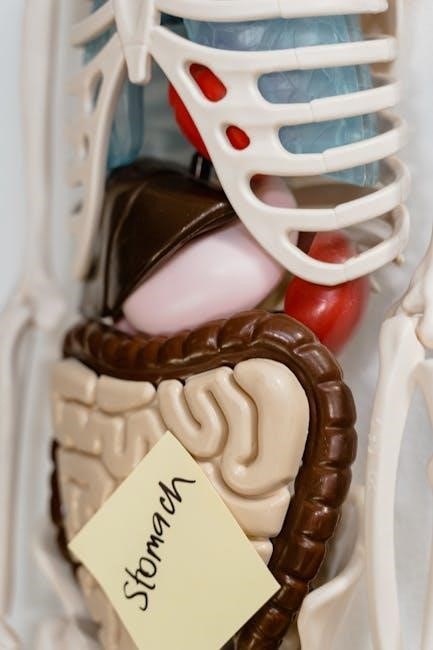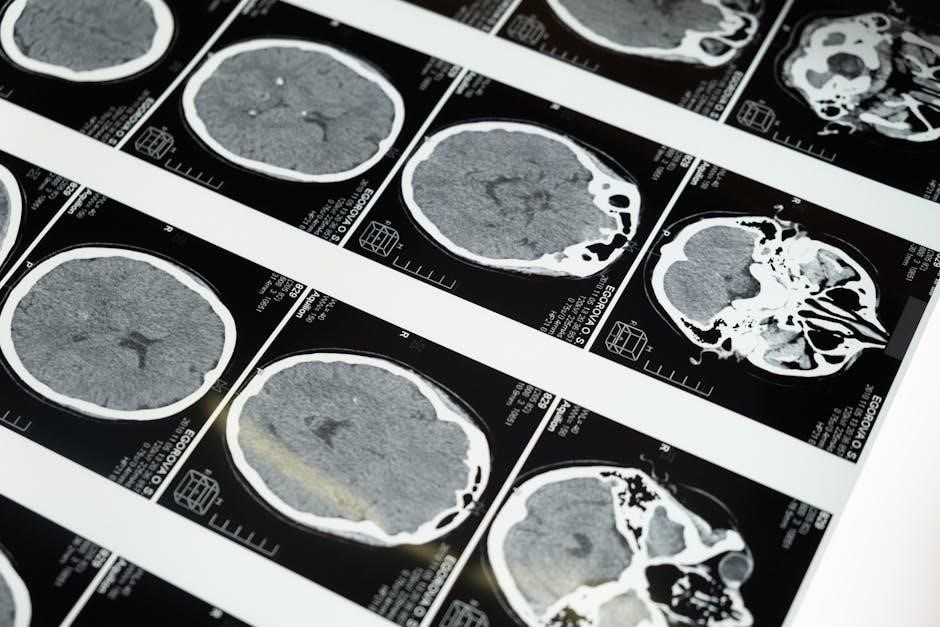Fundamentals of Anatomy and Physiology 11th Edition PDF: An Overview
The 11th Edition of “Fundamentals of Anatomy & Physiology” provides an accessible narrative, precise visuals, and accuracy. It’s designed for biomedical, life science, and health majors, focusing on effective art utilization for learning.
Book Details: Title, Edition, Authors
The “Fundamentals of Anatomy & Physiology,” 11th Edition, is a comprehensive textbook authored by Frederic H. Martini, Judi L. Nath, and Edwin F. Bartholomew. This edition serves as a valuable resource for students in biomedical, life science, and health-related fields. The book provides detailed insights into the human body’s structure and function, organized by body system. Its ISBN is 0134396022, encompassing 1296 pages of in-depth knowledge. The authors crafted this edition to present complex concepts in an accessible manner with precise visuals, making it a core resource for understanding human biology.
Availability of the PDF Version
The PDF version of “Fundamentals of Anatomy & Physiology,” 11th Edition, is available through various online platforms. Some sources offer it for free download, while others may require a purchase or subscription. Potential download locations include educational resource websites and online libraries. Users should exercise caution and verify the legitimacy of download sources to avoid copyright infringement or malware risks. Always consider ethical downloading practices. Ensure that any downloaded material is used in accordance with the publisher’s terms and conditions, respecting intellectual property rights and usage restrictions.

Key Features of the 11th Edition
This edition features an easy-to-understand narrative, precise visuals, and a focus on effective art utilization. It includes content relevant to students outside the United States through its Global Edition.
Easy-to-Understand Narrative and Precise Visuals
The 11th edition of “Fundamentals of Anatomy & Physiology” prioritizes clarity, presenting complex concepts through an accessible writing style. This approach ensures that students can readily grasp challenging topics within anatomy and physiology. Complementing the narrative are precise and detailed visuals, including illustrations and diagrams, which aid in comprehension by offering a visual representation of anatomical structures and physiological processes. These visuals are designed to reinforce learning and provide a multi-sensory approach to mastering the subject matter, making it easier for students to connect abstract ideas with concrete images.
Focus on Effective Art Utilization for Learning
This edition emphasizes how students use and process visual information. The art program is designed not just to illustrate, but to actively teach. Visuals are strategically crafted to highlight key concepts, simplify complex processes, and aid in memorization. By integrating art effectively, the textbook aims to improve students’ understanding and retention of anatomical and physiological principles. The visuals serve as a crucial learning tool, guiding students through intricate systems and structures, ultimately fostering a deeper and more meaningful engagement with the subject matter beyond traditional text-based learning methods.
Content Relevant to Students Outside the United States (Global Edition)
The Global Edition includes content especially relevant to students beyond the United States. Pearson’s editorial team worked with educators worldwide to ensure the material resonates globally. This adaptation incorporates diverse perspectives and examples, making the content more relatable and applicable to various healthcare systems and cultural contexts. By broadening the scope, the Global Edition fosters a more inclusive learning experience, preparing students for careers in an increasingly interconnected world. It bridges the gap between theory and practice by addressing diverse healthcare scenarios across different regions and populations, enhancing learning.

Content Organization and Scope
The book is organized by body system for clarity. It includes interactive resources to test knowledge and covers HAPS-based learning outcomes. This structure promotes effective learning and comprehensive understanding of anatomy and physiology.
Organization by Body System
The “Fundamentals of Anatomy and Physiology” 11th edition structures its content by body system. This organizational approach allows students to delve into each system comprehensively, exploring its specific anatomical structures and their corresponding physiological functions. By focusing on one system at a time, the textbook facilitates a deeper understanding of how individual components contribute to the overall function of the human body. This method supports a more coherent and integrated learning experience, enabling students to build connections between different aspects of anatomy and physiology within each system before moving on to the next.
Inclusion of Interactive Resources
The 11th edition incorporates interactive resources designed to enhance student engagement and knowledge retention. These resources often include online quizzes, animations, and interactive diagrams that allow students to actively participate in the learning process. By providing opportunities for self-assessment and exploration, the textbook encourages students to test their understanding of key concepts and identify areas where they may need further review. The inclusion of interactive elements aims to create a more dynamic and effective learning environment, fostering a deeper and more meaningful comprehension of complex anatomical and physiological principles through active participation.
Coverage of HAPS-Based Learning Outcomes
The eleventh edition thoroughly addresses the learning outcomes established by the Human Anatomy and Physiology Society (HAPS). By aligning its content with HAPS guidelines, the textbook ensures comprehensive coverage of essential topics. This alignment provides students with a strong foundation in core concepts, preparing them for success in their studies. The inclusion of HAPS-based learning outcomes also assists instructors in designing curricula. This approach ensures students receive a well-rounded education in anatomy and physiology that meets industry standards. The textbook serves as a valuable resource for mastering the fundamental principles.
Where to Find and Download the PDF
Links to download the “Fundamentals of Anatomy & Physiology” 11th Edition PDF can be found online. Exercise caution when downloading, ensuring the source is reputable to avoid potential security risks.
Links to Download Sources
Finding direct links to download the PDF of “Fundamentals of Anatomy & Physiology,” 11th Edition, often involves searching digital libraries, online repositories, and educational platforms. Some sites may offer direct downloads, while others might require registration or a subscription. It’s crucial to verify the legitimacy of the source to prevent malware or copyright infringement. Always prioritize secure websites and consider using trusted academic resources. Be aware that some links may no longer be active or lead to older editions. Check user reviews or forums for updated and reliable download locations.
Considerations for Downloading
When downloading the “Fundamentals of Anatomy & Physiology,” 11th Edition PDF, several factors warrant careful consideration. Prioritize downloading from reputable sources to avoid potential malware or viruses. Always verify the file’s integrity by checking its size and format. Be mindful of copyright laws; unauthorized distribution is illegal. Consider your device’s storage capacity and ensure sufficient space. Using a stable internet connection is crucial for a smooth download. If possible, scan the downloaded file with antivirus software. Lastly, remember that purchasing a legitimate copy supports the authors and publishers, ensuring continued high-quality educational resources.

Use as a Textbook for Biomedical, Life Science, and Health Majors
The “Fundamentals of Anatomy & Physiology,” 11th Edition PDF, serves as a valuable textbook for students pursuing biomedical, life science, and health-related fields. Its comprehensive coverage of body systems and interactive resources makes it an ideal tool for mastering complex concepts. The easy-to-understand narrative and precise visuals aid in effective learning. The textbook supports HAPS-based learning outcomes, ensuring students acquire essential knowledge. With its focus on anatomy and physiology, it’s particularly relevant for courses requiring a strong foundation in these subjects, preparing students for advanced studies and professional careers in healthcare.
Accessibility and Cost
The 11th Edition PDF’s accessibility varies, with some sources offering it as a free resource. Alternative editions and formats exist, potentially impacting the overall cost depending on the chosen format and availability.
Availability as a Free Resource
Finding the “Fundamentals of Anatomy and Physiology” 11th Edition PDF as a free resource can be challenging, but possible. Some websites offer downloads, though their legality and safety should be carefully considered. Open educational resource platforms or online repositories might host the PDF, aiming to provide accessible learning materials. Always verify the source’s trustworthiness and scan downloaded files for potential malware. Remember copyright laws and ethical considerations when accessing and using potentially copyrighted material for free. Check with your institution’s library for legal and safe access options.
Alternative Editions and Formats
Besides the PDF, “Fundamentals of Anatomy and Physiology” 11th Edition is available in various formats to suit different learning preferences. These include hardcopy textbooks, often preferred for their tactile nature and ease of annotation. E-book versions, accessible on devices like Kindle or tablets, provide portability and searchability. Furthermore, older editions, such as the 9th edition, might be more readily available or affordable. Consider exploring options like the Global Edition or adapted versions, which may offer slightly different content relevant to specific regions or curricula. Check for bundled packages that include supplementary materials.

Supplementary Materials
To enhance learning, the 11th edition offers supplementary materials. These resources include test banks for assessment, lecture presentations for instructors, and interactive tools to reinforce understanding of complex concepts.
Test Bank Availability
A comprehensive test bank accompanies the “Fundamentals of Anatomy & Physiology, 11th Edition” to aid in student assessment. This resource, designed for instructors, includes a variety of question types covering all chapters of the textbook (Chapters 1-29). The test bank is available for download in formats such as PDF, allowing for easy integration into course management systems. It helps educators gauge student comprehension and tailor instruction effectively. The test bank ensures that students have ample opportunity to test their knowledge and prepare for exams. This supplementary material is crucial for effective teaching.
Lecture Presentations
Lecture presentation slides are available as supplementary materials for the “Fundamentals of Anatomy & Physiology, 11th Edition.” These presentations, often in PowerPoint (.ppt/.pptx) and PDF formats, provide instructors with ready-made visual aids to enhance their lectures. The slides cover key concepts and topics from each chapter, aligning with the HAPS-based learning outcomes. These resources save educators time in preparing engaging and informative lectures. They offer a structured framework for presenting complex anatomical and physiological information, aiding student comprehension and retention. The presentations are a valuable tool for effective teaching and learning.
Adaptations and International Editions
The “Fundamentals of Anatomy & Physiology, 11th Edition” has been adapted for international audiences, including a Global Edition. These adaptations often include content relevant to students outside the United States. The international editions may feature examples, case studies, and perspectives that reflect diverse healthcare systems and cultural contexts. Furthermore, authorized adaptations ensure content accuracy while catering to specific regional needs. These editions maintain the core principles of anatomy and physiology, ensuring accessibility and relevance for students worldwide. Such adaptations enhance the learning experience by providing a global perspective on human health.
Relevance to Anatomy and Physiology Courses
“Fundamentals of Anatomy & Physiology, 11th Edition” is highly relevant for introductory anatomy and physiology courses. The textbook provides a solid foundation in the subject matter, covering essential concepts and principles. Its easy-to-understand narrative and precise visuals aid comprehension for students new to the field. The book’s organization by body system aligns with typical course structures. Interactive resources included enhances student learning. Furthermore, the content’s accuracy and comprehensive coverage of HAPS-based learning outcomes make it suitable for various health science programs. It supports students in biomedical, life science, and other health-related disciplines.
Comparison with Other Editions
The 11th edition features updated visuals and narrative compared to earlier editions like the 9th. It relates to textbooks like “Principles of Anatomy and Physiology 16th Edition” but offers a different approach.
Differences from Earlier Editions (e.g., 9th Edition)
The 11th edition of “Fundamentals of Anatomy & Physiology” incorporates recent research on visual learning. This edition helps students effectively use art to learn A&P, a key difference from the 9th edition. The narrative is more accessible, and visuals are more precise. The 11th edition contains updated content and learning tools, differing from previous editions. It includes HAPS-based learning outcomes and teaching points. The 11th edition focuses on clarity and effective visual aids, unlike older versions with potentially less emphasis on these elements.
Relationship to Other Textbooks (e.g., Principles of Anatomy and Physiology 16th Edition)
“Fundamentals of Anatomy & Physiology,” 11th Edition, shares core concepts with other textbooks like “Principles of Anatomy and Physiology,” 16th Edition. However, “Fundamentals” prioritizes an accessible narrative and precise visuals. The 16th edition of “Principles” may offer more in-depth coverage and clinical correlations. “Fundamentals” is often used in introductory courses, whereas “Principles” might be used in more advanced studies. Both cover essential anatomy and physiology, but differ in depth, scope, and pedagogical approach. Students might use both for comprehensive understanding, depending on course requirements and learning preferences.

